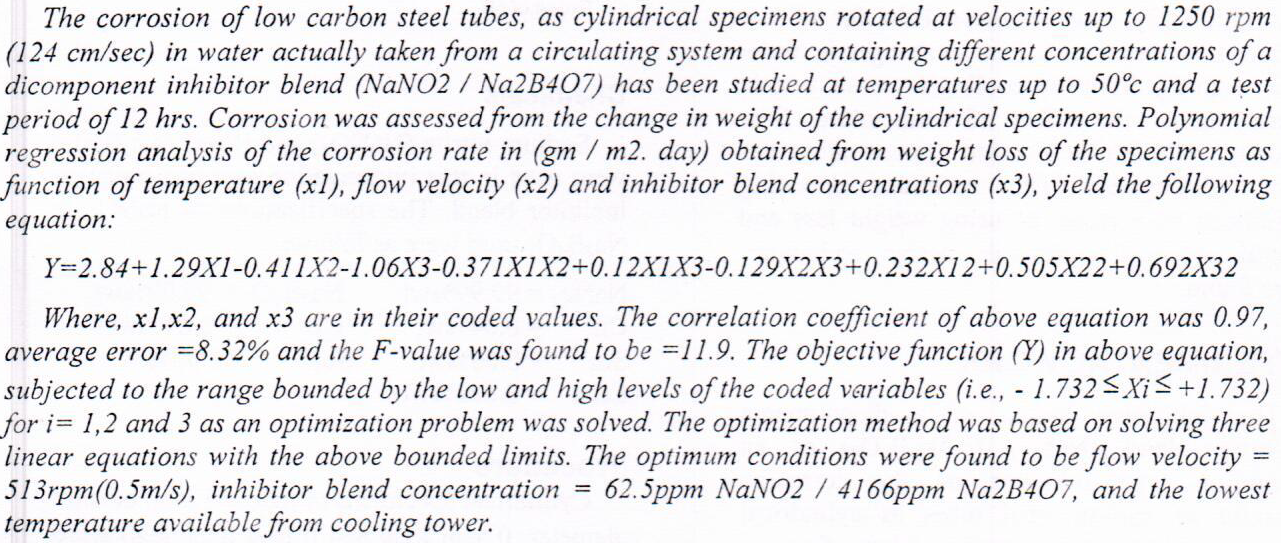
 (60)
(60)
 (51)
(51)
A thin CdS Films have been evaporated by thermal evaporation technique with different thicknesses (500, 1000, 1500 and 2000Å) and different duration times of annealing (60, 120 180 minutes) under 573 K annealing temperature, the vacuum was about 8 × 10-5 mbar and substrate temperature was 423 K. The structural properties of the films have been studied by X- ray diffraction technique (XRD). The crystal growth became stronger and more oriented as the film thickness (T) and duration time of annealing ( Ta) increases.
A simple, fast, selective of a new flow injection analysis method coupled with potentiometric detection was used to determine vitamin B1 in pharmaceutical formulations via the prepared new selective membranes. Two electrodes were constructed for the determination of vitamin B1 based on the ion-pair vitamin B1-phosphotungestic acid (B1-PTA) in a poly (vinyl chloride) supported with a plasticized di-butyl phthalate (DBPH) and di-butyl phosphate (DBP). Applications of these ion selective electrodes for the determination of vitamin B1 in the pharmaceutical preparations for batch and flow injection systems were described. The ion selective membrane exhibited a near-Nernstian slope values 56.88 and 58.53 mV / decade, with the linear dy
... Show More (3)
(3)
In this paper, an eco-epidemiological prey-predator system when the predator is subjected to the weak Allee effect, and harvesting was proposed and studied. The set of ordinary differential equations that simulate the system’s dynamic is constructed. The impact of fear and Allee’s effect on the system's dynamic behavior is one of our main objectives. The properties of the solution of the system were studied. All possible equilibrium points were determined, and their local, as well as global stabilities, were investigated. The possibility of the occurrence of local bifurcation was studied. Numerical simulation was used to further evaluate the global dynamics and understood the effects of varying parameters on the asymptotic behavior of t
... Show More (3)
(3)
An experimental study was conducted with low cost natural waste adsorbent materials, barley husks and eggshells, for the removal of Levofloxacine (LEVX) antibacterial from synthetic waste water. Batch sorption tests were conducted to study their isothermal adsorption capacity and compared with conventional activated carbon which were, activated carbon > barley husks > eggshells with removal efficiencies 74, 71 and 42 % with adsorbents doses of 5, 5 and 50 g/L of activated carbon, barley husks, and eggshells respectively. The equilibrium sorption isotherms had been analyzed by Langmuir, Freundlich, and Sips models, and their parameters were evaluated. The experimental data were correlated well with the Langmuir model which gives the
... Show More (12)
(12)
To create a highly efficient photovoltaic-thermal (PV-T) system and maximise the energy and exergy efficiency, this study aims to propose an innovative configuration of a PV-T system comprising wavy tubes with twisted-tape inserts. Following the validation of a numerical model, a parametric study has been conducted to assess the geometrical effects of twisted tape and wavy tubes, as well as the coolant fluid type and velocity, on the overall performance of a PV-T system, located in Shiraz, Iran. It is found that employing twisted tape improves the energy and exergy efficiency by approx. 6.3%. The best configuration yields 12.4% and 16.8% increase in energy and exergy efficiency compared to conventional PV systems. This is achieved at 15% vo
... Show More (16)
(16)
 (10)
(10)
Cyclophosphamide which acts as cytotoxic alkylating agent can induce a renal damage through the toxic metabolites which result from metabolic activation of Cyclophosphamide by cytochrome P-450 inside hepatocyte and develop renal toxicity by direct binding with cellular organelles in the urinary tract cells. Guggulsterone is a sterol derived from plant has ability to bind to farsenoid X receptor, mineral corticosteroid receptor, androgen receptor, glucocorticoid receptor and estrogen receptor.
 (7)
(7)
 (6)
(6)
Suffer most of the facilities of the high cost of inventory , which affects the high cost of the product and thus affects many administrative decisions , as well as suffer the facilities of the systems developed by the provisions of inventory control , and this problem is exacerbated in the construction sector where the inventory in the form of Construction spin of the Year for another it becomes difficult to control the cost effectively , and is the research problem in question follows: What are the implications of the use of the system in time inventory accounting system for the contracting company does kills Alrkaah to the provisions of the cost of inventory and what is the optimal approach to inventory control ? Find assumed
... Show More (22)
(22)
 (23)
(23)
 (3)
(3)
